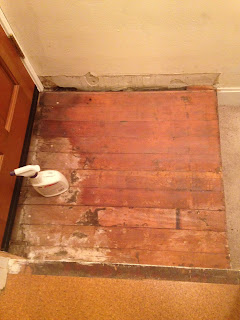Using chemical stripper is a messy, detestable task. I can now tell you that I prefer using a heat gun for this purpose. The stripper gives you the initial feeling that it's faster than the heat gun, but cleanup is a challenge, and once the wood is dry again, it doesn't sand well. The heat gun causes the paint to bubble up and any remaining traces are crispy and sand very easily. It's probably a tie on the time commitment, so go with the easier experience (heat gun).
Some would say that stripping the cabinets is overkill; that you only need to do a cursory sanding and then repaint. The people that say such things apparently don't know us.
 |
| Messy paint stripper. |
When the day came to tear out the old floor, I was eager to see what was underneath. We could tell that the floor had been built up about 3/4". When the top layer came off, it revealed a yellow-green vinyl, circa 1978 (best guess). Beneath that, an interesting brown-green linoleum pattern. I love to imagine what the kitchen looked like when it was new, and this was the missing piece to the visual in my mind.
 |
| Someone once loved this. |
|
 |
| Linoleum from c. 1930. |
|
As a contrast to how easily the top layer of floating floor came up, the linoleum had been installed with tar. The tar wouldn't scrape off or sand off, so we began looking for a different solution. I had hoped that maybe denatured alcohol or mineral spirits might do the trick. In the end, the only thing that seemed to help at all was the expensive chemical stripper. Mostly, we just wanted to get enough of the tar up so that we had a reasonably level surface for the new floor.
 |
| Tar mess with paint stripper. |
|
 |
| After cleanup. It's okay. |
|
Fast forward a couple of years, and through the gift of a small potty accident while dog sitting, I now know the secret solution to getting tar off the floor. Ammonia! A simple diluted solution of ammonia left to soak for only about 20 seconds will pull the tar up like a dream. Doh!
 |
| Tar on floorboards. |
|
 |
| 5 minutes later - after ammonia. |
|








Very interesting. Your kitchen actually reminds me of the kitchen of my childhood, which had probably been updated in the 1930s. The cupboards were painted white and the door handles were red. The linoleum was swirly -- maybe red, yellow, green -- with red around the edges. The wallpaper in the breakfast room was white with red cherries. A white kitchen is still my favorite but didn't happen for me.
ReplyDeleteCorrection: HASN'T happened for you. I like different kinds of styles--we had a modern feel at the condo and this house has taken us down a vintage path. I'm sure in a future house, I'll enjoy researching and appreciating some other style. I hope we'll have a chance to do a real kitchen remodel and we'll have to consider exactly what we want it to look like. I should probably start dreaming about it now given our pace of decision making.
DeleteIt's been my experience that contractors and cabinetmakers are not in favor of painted cabinets, while BHG shows white kitchens galore. But my mother had painted cabinets in her kitchen -- both the old and the remodeled -- and I thought they were lovely. They're also washable, repaintable, and very vintage!
DeleteIt IS good to appreciate the great variety that's available.
I wanted to put linoleum in the farm but we couldn't find any.
ReplyDeleteI think a Scandinavian company was making it, but it was expensive and not quite vintage in appearance.
Delete